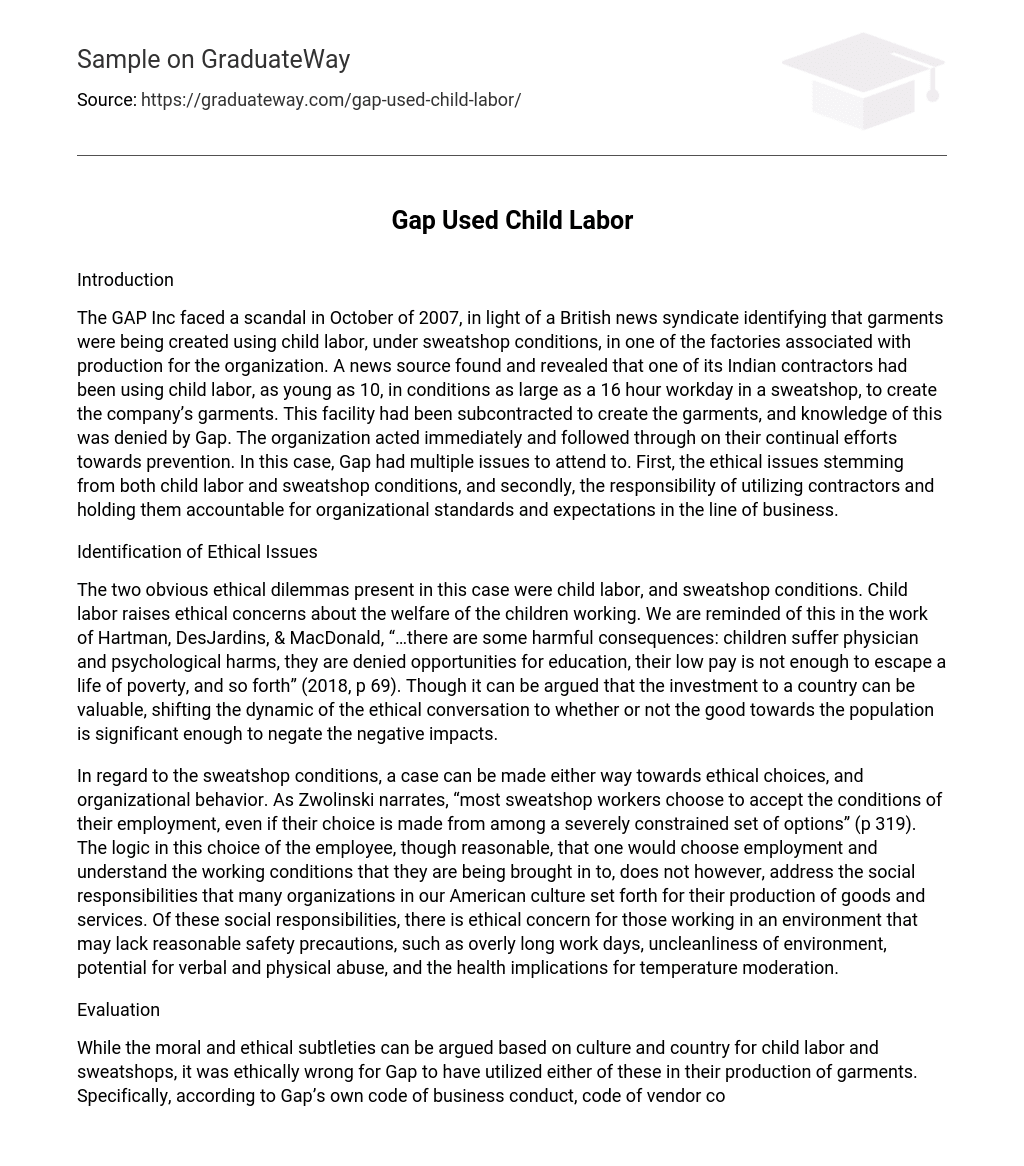Introduction
The GAP Inc faced a scandal in October of 2007, in light of a British news syndicate identifying that garments were being created using child labor, under sweatshop conditions, in one of the factories associated with production for the organization. A news source found and revealed that one of its Indian contractors had been using child labor, as young as 10, in conditions as large as a 16 hour workday in a sweatshop, to create the company’s garments. This facility had been subcontracted to create the garments, and knowledge of this was denied by Gap. The organization acted immediately and followed through on their continual efforts towards prevention. In this case, Gap had multiple issues to attend to. First, the ethical issues stemming from both child labor and sweatshop conditions, and secondly, the responsibility of utilizing contractors and holding them accountable for organizational standards and expectations in the line of business.
Identification of Ethical Issues
The two obvious ethical dilemmas present in this case were child labor, and sweatshop conditions. Child labor raises ethical concerns about the welfare of the children working. We are reminded of this in the work of Hartman, DesJardins, & MacDonald, “…there are some harmful consequences: children suffer physician and psychological harms, they are denied opportunities for education, their low pay is not enough to escape a life of poverty, and so forth” (2018, p 69). Though it can be argued that the investment to a country can be valuable, shifting the dynamic of the ethical conversation to whether or not the good towards the population is significant enough to negate the negative impacts.
In regard to the sweatshop conditions, a case can be made either way towards ethical choices, and organizational behavior. As Zwolinski narrates, “most sweatshop workers choose to accept the conditions of their employment, even if their choice is made from among a severely constrained set of options” (p 319). The logic in this choice of the employee, though reasonable, that one would choose employment and understand the working conditions that they are being brought in to, does not however, address the social responsibilities that many organizations in our American culture set forth for their production of goods and services. Of these social responsibilities, there is ethical concern for those working in an environment that may lack reasonable safety precautions, such as overly long work days, uncleanliness of environment, potential for verbal and physical abuse, and the health implications for temperature moderation.
Evaluation
While the moral and ethical subtleties can be argued based on culture and country for child labor and sweatshops, it was ethically wrong for Gap to have utilized either of these in their production of garments. Specifically, according to Gap’s own code of business conduct, code of vendor conduct, and human rights policy, and the UK Modern Slavery Act (all which can be found on their website, at https://www.gapincsustainability.com/policies), the concerning activity found regarding Gap’s subcontractor would be considered ethically wrong for their organization, as well as for the general consensus of the American culture. Gap takes ownership of the actions of their contracted factories, and in this case, despite being unaware and not informed properly of the usage of a subcontractor to complete the outsourced order, Gap is, under their own expectations, responsible for the actions of said subcontractor. Not only do they state this in policy, but Gap also backs up their word by rebuilding in areas in which it finds non-compliance, through ensuring that the children in these locations get proper schooling and wages (to commiserate with loss of work), as well as offering of a factory job once they are old enough. This type of interaction sets a precedence and expectation on behalf of the company. Additionally, the UK Modern Slavery Act addresses the working conditions of those employed, as well as international labor laws, both of which Gap is also committed to upholding.
Root Cause Analysis
In my opinion, though the situation was singular, this problem as a whole would be considered a systemic problem for Gap. The facts in place denote that a year prior, Gap had completed an internal audit of their contractors, and found that 23 factories had failed meet their expectations, having their licenses revoked. Even without the source providing more detailed reasons for the ending of these contracts, this paints a strong picture of inconsistent behaviors of their contracted factories, and each one standing as a large liability to the organization. Gap happens to do a significant amount of its production outsourcing to Asia, which also, according to the BBC (2007), employs more than half of the world’s “215 million child workers”.
The root cause of the issue at hand, is the outsourced activity to factories that may not be able to be monitored as closely as Gap should, for the fulfilling of their policies and commitments to their consumers. Though contractors are expected to abide by the agreements they enter, the organization they work for takes on significant risk. As Gap likely assessed their risk prior to outsourcing, they would be well aware of the average working conditions in a region that may not fall within their scope of expectation and can reasonably determine that there may be additional consequences to doing business in a particular location despite a written agreement.
Conclusion
In conclusion, while the Gap has very strong policies, practices and procedures for handling their goods and manufacturing, they are not immune to inconsistencies and ethical concerns within their labor practices. Their issues arising from child labor, sweatshop working conditions, and contractual violations through subcontracting on an unapproved basis, are not surprising based on their locations chosen for outsourcing, and the findings of their internal audits. Additional internal controls and risk analysis should be considered by this organization to avoid this problem in the future, ensuring that they are able to effectively monitor their factory sites, both at home and overseas, for compliance contractually, ethically, and in regard to the company’s social responsibility platforms.





